|
|
|
|
|
|
| ADVERTORIAL |
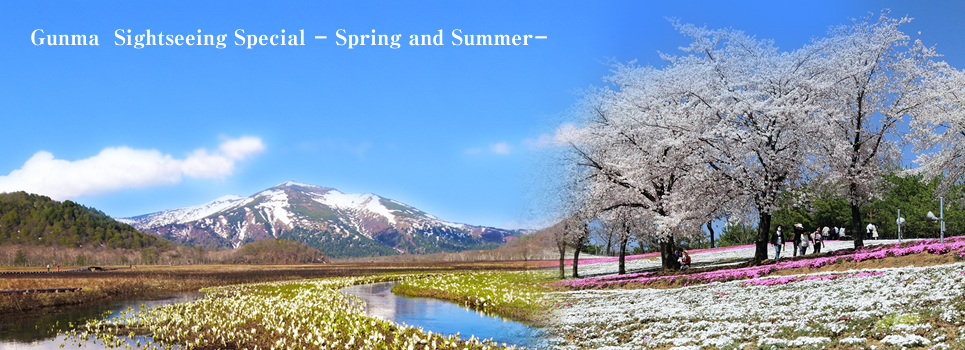
![]()
Gunma Prefecture, an hour's ride from Tokyo on the Shinkansen, is blessed with rich natural surroundings. Here the mountains, lakes, highlands, rivers and forests offer you the chance to witness beautiful seasonal landscapes year-round.
Gunma Prefecture is also the best onsen (hot spring) place in Japan. There are over 200 onsen here, each with its own unique character.
Here we present visitors to Japan with the best spots in each area of Gunma. Why not come to Gunma to enjoy the kaleidoscopic displays of blooming flowers and the lush fields and hills of spring, as well as traditional festivals and intense water sports in summer?
Relevant Links
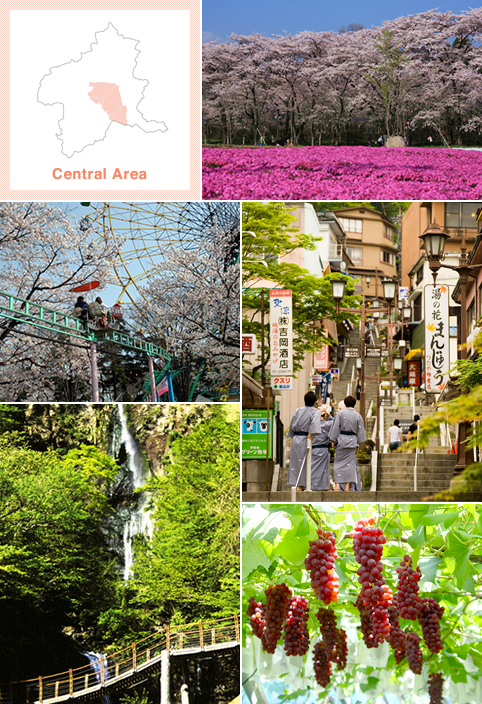 Clockwise from top left: map of central area; Akagi Nanmen Senbonzakura; Ikaho Onsen Stone Steps; grape orchard; Funao Waterfall; Kezoji Park
Clockwise from top left: map of central area; Akagi Nanmen Senbonzakura; Ikaho Onsen Stone Steps; grape orchard; Funao Waterfall; Kezoji Park
In the prefecture's central area, the coming of spring is accompanied by flowers that bloom into a dazzling panoply of color at numerous famed gardens, where visitors find their souls soothed.
The best places to view the cherry blossoms are at Maebashi Park, Akagi Nanmen Senbonzakura and Ogo Green Flower Pasture in Maebashi City and at Kezoji Park in Isesaki City.
In addition to the cherry blossoms, the area boasts a wide range of other flowers that come into bloom one after another in a virtual relay from spring to summer. They include the roses at Shikishima Park, the azaleas of Mt. Akagi and Kezoji Park, the Japanese irises at Akabori Japanese Iris Garden and the lotus flowers at Akabori Lotus Garden.
Meanwhile, summer wouldn't be summer without the original festivals each community puts on.
For example, Shibukawa City, said to be "the center of Japan" or "the belly button of Japan," organizes the unique Heso ("Navel") Festival as well as Japan's biggest hula festival held in Ikaho, both of which put on a fantastic show.
In addition, Shinto Village and Yoshioka Town have about 50 orchards in total for picking grapes, where, beginning in August, visitors can enjoy picking all sorts of grape varieties like Delaware and Kyoho, as well as sample or purchase wine at the nearby winery.
After grape picking you can visit beautiful Funao Waterfall to see waters plummeting amidst the lush surrounding in what looks like a single white sheet hanging from the top of the cliff.
Accommodations with an English website and online booking in English available
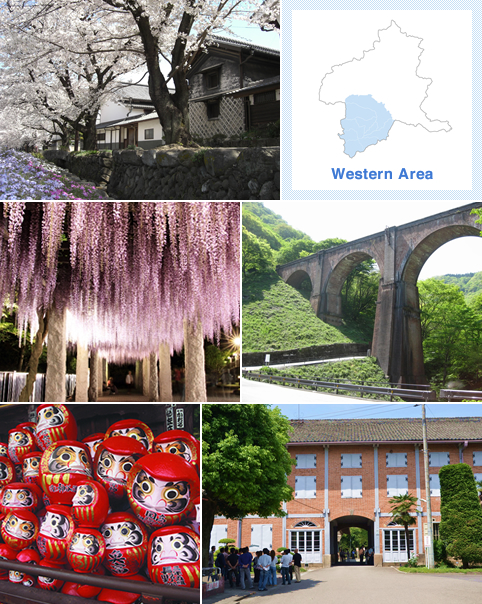 Clockwise from top left: Castle Town Obata; map of western area; Megane Bridge, Usui Pass railway heritage site; Tomioka Silk Mill; Syorinzan Darumaji; Fuji no Saku Oka
Clockwise from top left: Castle Town Obata; map of western area; Megane Bridge, Usui Pass railway heritage site; Tomioka Silk Mill; Syorinzan Darumaji; Fuji no Saku Oka
Gunma's western area, centered in Takasaki, which has long been an important point of traffic, has numerous spots where the history and tradition are tangible.
Tomioka Silk Mill, which hopes to be listed as a UNESCO World Heritage Site in 2014, was built 140 years ago by the Japanese government as a model silk-reeling factory, the country's first. The structure, constructed with a wooden frame and brick walls, is still in almost perfect condition, even after operating for over a century.
Some nice things to do in Castle Town Obata are walking under the cherry blossom trees that line streets where houses dating back to the Edo period still stand, and strolling through Rakusan-en, the prefecture's only garden that was built by a "daimyo" feudal lord.
There are plenty of other charming locations and events to enjoy, such as: Syorinzan Darumaji, birthplace of Takasaki Daruma, a typical good luck charm in Japan; Ansei Toashi ("Samurai Marathon"), held in May, in which costumed runners race along Nakasendo (a highway in Edo-period) in Japan's oldest marathon; Usui Pass railway heritage sites; Kirizumi Onsen, which was the setting of a movie, and Isobe Onsen; Haruna Shrine, a very popular "spiritual vortex"; and Mt. Myogi, one of Japan's three great places of scenic beauty.
In March, the ume (Japanese apricot) blossoms come into bloom at Akima, Haruna and Misato Ume Gardens, which have the largest producing area of any ume garden in eastern Japan. Then in April, at Fuji no Saku Oka, the wisteria flowers along the 250-meter-long trellis bloom beautifully as if competing for your eyes' attention. During the Wisteria Festival in late April, they are illuminated at night, wrapping the area in a fantastical ambience.
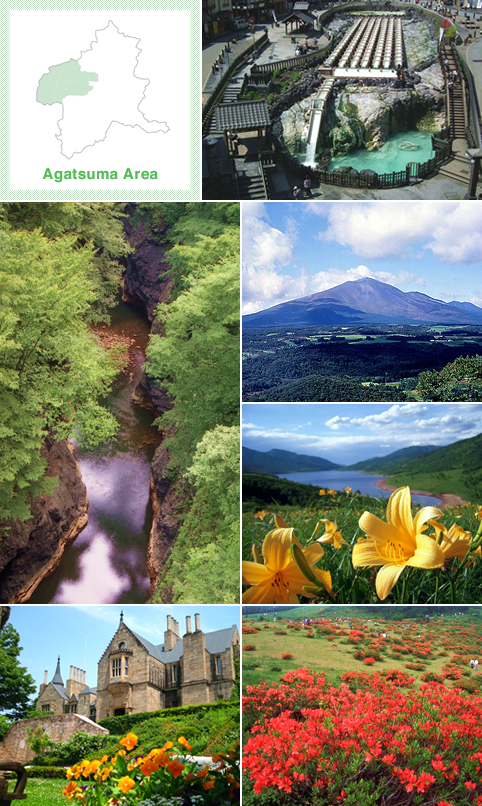 Clockwise from top left: Map of Agatsuma area; Yubatake, a hot spring in Kusatsu Onsen; Mt. Asama; Lake Nozori; Kazama Yunomaru Plateau; Lockheart Castle; Agatsuma Gorge
Clockwise from top left: Map of Agatsuma area; Yubatake, a hot spring in Kusatsu Onsen; Mt. Asama; Lake Nozori; Kazama Yunomaru Plateau; Lockheart Castle; Agatsuma Gorge
The Agatsuma area is very popular as a summer resort for its low humidity and refreshing weather during that season, and it is also attractive for its rich natural surroundings and quality onsen.
For those who want to see superb natural scenery or have a great time out in nature with views of majestic Mt. Asama, we recommend golf, camping, trekking and other outdoor sports. Trekking courses range from easy hiking in Agatsuma Gorge to full-scale high-altitude trekking in the mountains.
After getting your fill of the outdoors, there is a wide variety of onsen you can choose from to wash away the sweat and rejuvenate your weary body. Kusatsu Onsen, one of Japan's three famed onsen, has topped the list of "Japan's Best 100 Onsen" for 10 years running and is bustling with the many visiting tourists year-round. Other renowned springs besides Kusatsu Onsen include Manza Onsen, where visitors can indulge in a hot spring bath while looking out on the magnificent landscape.
Another of this area's draws is the chance to encounter rare alpine plants. In addition to flowering plants like dicentra and daylilies, the area is a treasure trove of flowers rarely seen elsewhere, such as rhododendron of Asama Plateau and Japanese azalea of Kazawa Yunomaru Plateau. Especially in July, when daylilies come into bloom along Lake Nozori in Nakanojo Town, the lakeshore transforms into fields of yellow that make for impressively beautiful scenery.
The Agatsuma area is also home to many places of interest such as: the Gunma Astronomical Observatory, which holds a reflecting telescope that is among the world's largest; Lockheart Castle, an old European castle transported to Japan and rebuilt here; and the fireflies that dance over the fresh Hakoshima Spring Waters from June to July.
Accommodations with an English website and online booking in English available
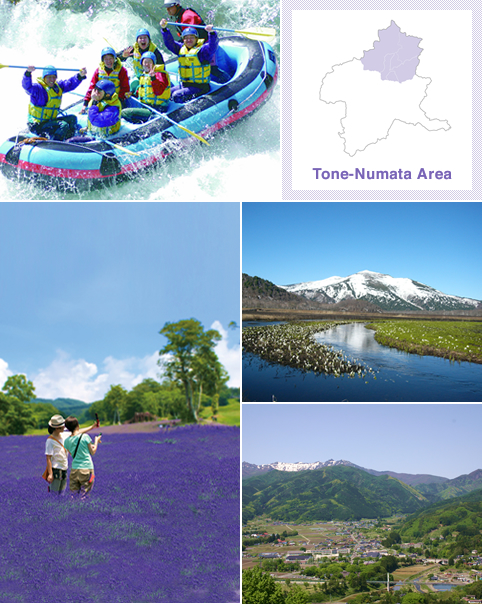 Clockwise from top left: rafting; map of Tone-Numata area; Oze National Park; panoramic view of Kawaba Village; Tambara Lavender Park
Clockwise from top left: rafting; map of Tone-Numata area; Oze National Park; panoramic view of Kawaba Village; Tambara Lavender Park
The Tone-Numata area, where the source of Tone River is found, is a place of great natural charm blessed with beautiful mountains and plentiful water.
At Oze National Park, one of the world's treasure troves of precious natural beauty, the Asian skunk cabbage and the 300-year-old Tennozakura cherry blossom tree come into full bloom in spring, while daylilies blossom in summer.
The area's natural surroundings also offer plenty of outdoor sports. You can go rafting in Minakami Town, which is even more thrilling to do in the spring and summer, when the snowmelt raises the water level. The variety of outdoor activities also includes canoeing, canyoneering, bungee jumping and more.
Kawaba Village is blessed with alluring and abundant nature that features a colorful array of blooming flowers and lush greenery. And here you can have fun camping or climbing Mt. Hotaka, one of Japan's 100 famed mountains.
There is plenty of other unique scenery you can come across in this area as well, like the cherry blossoms at Numata Park, the lavender fields at Tambara Lavender Park, and Fukiware Falls, the "Niagara of the Orient."
Accommodations with an English website and online booking in English available
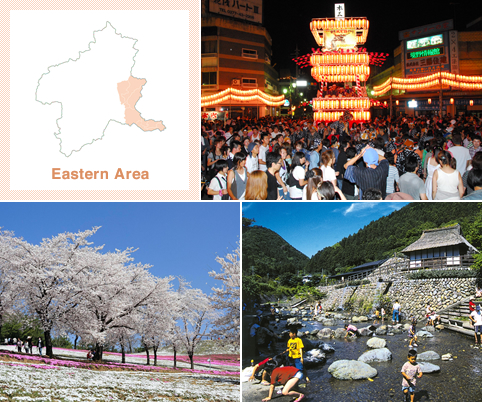 Clockwise from top left: map of eastern area; Kiryu Yagibushi Festival; Kodaira no Sato; Ota City Northern Athletic Park
Clockwise from top left: map of eastern area; Kiryu Yagibushi Festival; Kodaira no Sato; Ota City Northern Athletic Park
The eastern area has a unique group of towns including the industrial city Ota, the textile-producing city, Kiryu, and a city of fresh waters and greenery, Midori.
Kiryu Yagibushi Festival, which will celebrate its 50th anniversary this year, is known as one of the three great nighttime festivals of the Kanto region. During the festival, the town of Kiryu is full of excitement and the sounds of the Yagibushi folk song and dance.
The area has various foods characterized as "B-grade gourmet," a Japanese term referring to ordinary yet delicious food, such as himokawa udon, 1.5 to 12-centimeters-wide, in Kiryu; Joshu-Ota yakisoba in Ota; and much more. An interesting cooking experience that is unique to this area is the Old Stone Age-style food. You can experience it at Iwajuku Ruins, one of Japan's important sites of the Old Stone Age.
There are many places the whole family can enjoy, be it viewing the moss phlox flowers in Ota City Northern Athletic Park, playing in the river and catching trout at Kodaira no Sato, or relaxing at Yabuzuka Onsen. We also recommend visiting historical ruins that are called Taiheiki no Sato, linked to Nitta Yoshisada, a famous figure from 14th-century Japan.